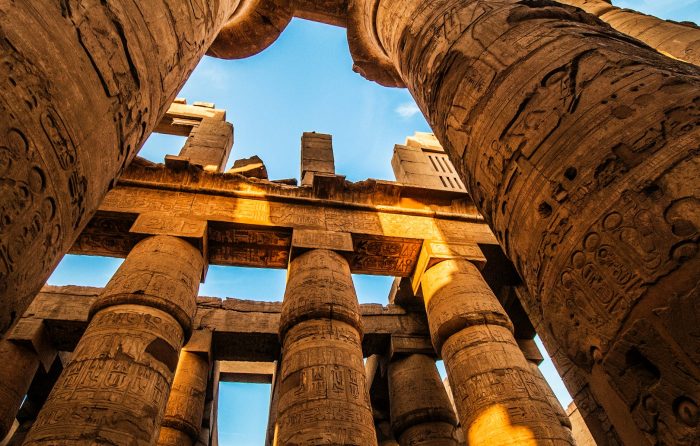Who Was This Queen?
Egypt is a culture rich in history. It spans a period of over 3,000 years, and holds some of the most astounding characters of any historical record. From Ramses to Akhenaten, the kings of Egypt never fail to amaze us.
Although, Egypt was a culture which also revered the other sex: Women. The image of the goddesses Hathor, Nephthys and her infamous sister Isis persist to this day. These sister goddesses embody much of the how the ancient Egyptians viewed women: powerful, independently important, and active creators of life and society.
There is one woman who stands out amidst the rest of the queens and goddesses of Egypt and that is because she did one further. She took the place of the man. She was no queen or goddess, she was a king.
The girl who became king
Hatshepsut was born to Thutmose I and Ahmose, in the eighteenth dynasty. Her father was the Pharoah of Egypt, so from the outset she was born into the life of a royal. As most women in her status she could read and write in the sacred language of hieroglyphics, which would service her well as a stateswoman.
Hatshepsut was married to her brother, Thutmose II, and became queen consort of Egypt. Although, shortly after the birth of his son Thutmose III, Thutmose II died. Hatshepsut was not the mother of this boy, but she was still queen and reigned as such until the boy came of age.
At least, that was what was expected.
Shocking Fact #1: Ascending the throne
It only took this ambitious queen a short while to transform herself from acting regent into a full blown Pharaoh. She began this reign as the dutiful queen, arrayed in the garments of a queen.
Hatshepsut, however, apparently understood the power of imagery. As word began to spread about the young man, Thutmose III, ascending the throne she seemed to hold more tightly to her position. Gone were the female garments, the soft features of feminine beauty and splendor.
Her entire display becomes that of a man. Her face is stern and rigid, her arms are the sinews of a man and she wears the kilt of the king.
The one thing which was most shocking, however, was the false heard of the Pharaohs. Strapped to her chin like her predecessors and the great god Osiris himself is the false beard of the kings.
This is an amazing thing for 2 reasons. First, is the rather obvious link with her heritage to the gods as a Pharaoh. She is linked with the god Osiris in wearing this beard, and thus assumes the power as king. The second, less obvious statement, is the connection with the goddess Isis.
It was through the re-birthing of the god by his goddess sister-wife, Isis, that the dead god became alive once more. Hatshepsut could very well have been singing the praises of the woman here: it is through us that life is given. We hold the true power.
Shocking Fact #2: The warrior queen
On the temple walls of her funeral temple of Deir Al-Bahari, their are notes of the female Pharaoh leading her soldiers to battle. Hatshepsut’s reign was overwhelmingly peaceful, however, as every good Pharaoh before her, Hatshepsut asserted herself as the leader of her armies.
Although no wars were fought during her reign, there was a rebellion in Palestine which she swiftly squashed, as well as having a victorious conflict with the Nubians to the south. One thing was made plain, she did not tolerate those who questioned her authority. She asserted herself again as king through her military might on both occasions.
On the temple walls she seemed to reaffirm this clearly: This is my land. My people. I am their king.
There is disagreement over whether she actually led her soldiers herself, or if this was embellishment. Although, most Pharaohs really did lead their soldiers, so it is very likely she really did accompany them on military campaigns as did her male predecessors.
Shocking fact #3: The king of prosperity
Hatshepsut ruled her kingdom with an iron fist; however, her reign was very peaceful. Egypt had entered an era of abundance, and many saw this as the blessings and approval of the female ruler who fought so tirelessly for affirmation from the state.
During her reign she created excellent trade deals with the Puntites and Nubians among other nations. One of her favorites imports was Myrrh which she wrote beautifully about. She also brought business to Egypt through these trade agreements, and craftsmen experienced a fair share of business during this period.
In this manner she showed herself an intelligent stateswoman, as well as a powerful leader.
Shocking fact #4: Was she the evil step-mother?
So, this header ended in a question mark, and is not really a fact so much as a debate among scholars. Was Hatshepsut accepted by the people and by her own step-son? Did he see this woman as a usupper of his rightful throne? Or, did he see her as the protectress of his legitimacy?
Traditionally, many saw this woman as a violator of “natural law”: a woman who dared become a man to steal her step-son’s rightful throne. Many proponents of this theory point to the fact that her step-son proceeded to erase much of the writings of this female queen from records. He must have really hated her, right?
Well, not so fast.
There is actually good reason to view this as a strategic move to preserve Thutmose’s III claim to legitimacy. Many scholars believe that Hatshepsut was more or less placed in the position of king by her loyal subjects in the court of her service. This was done to prevent other claimants to the throne from attesting to the long wait for Thutmose III to come of age.
Hatshepsut was the only one who could prevent this from happening by becoming king herself. Then, Thutmose gradually took on more and more of the responsibilities as Pharaoh in her stead, until she passed away and he took complete control. Her name was removed not out of hate, but rather to retain a complete, uninterrupted male royal lineage.
Rather than seeing them as enemies, we could see this female Pharaoh as actually doing everything in her power to assure her step-son got to the throne of Egypt.












Read 0 comments and reply